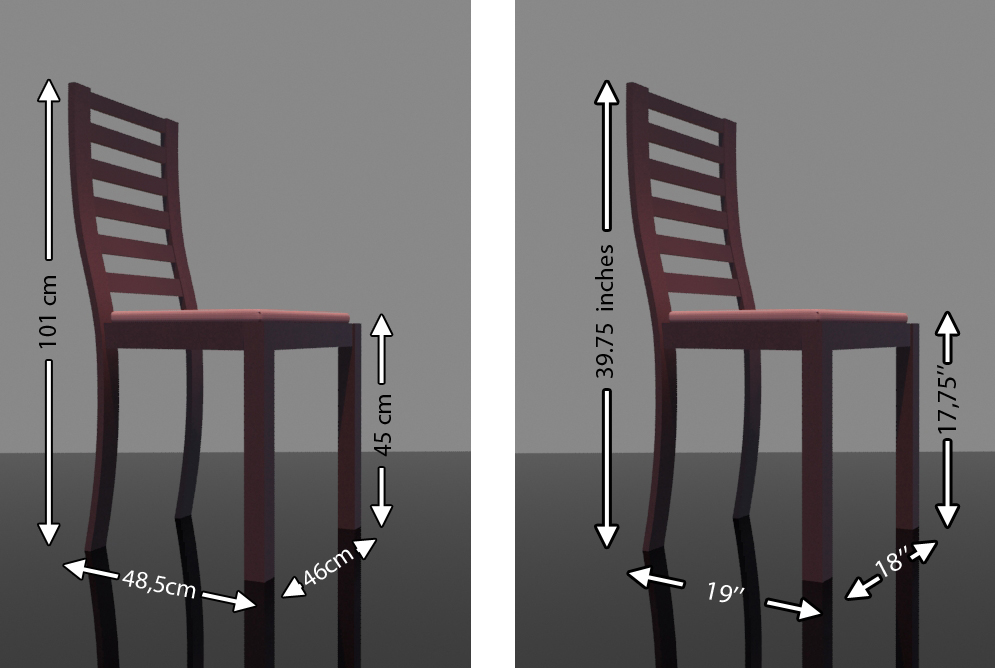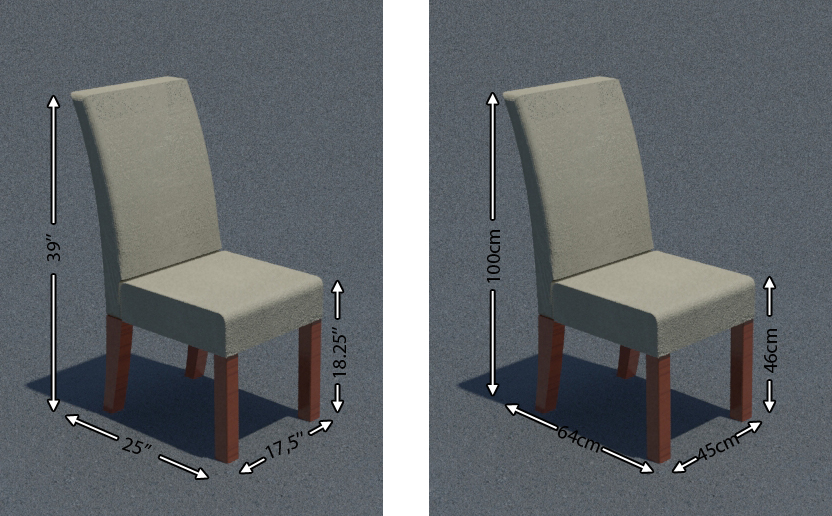Standard Dining Chair Dimensions: Average Dining Chair Width

The width of a dining chair is a crucial factor to consider when planning your dining space. A chair that is too narrow can be uncomfortable, while a chair that is too wide can make the room feel cramped. Understanding the typical width range of standard dining chairs can help you choose the right size for your needs and ensure a comfortable and aesthetically pleasing dining experience.
Standard Dining Chair Widths
Standard dining chairs typically range in width from 18 to 22 inches. However, this range can vary depending on the chair’s style, materials, and intended use. For instance, chairs with wider seats, such as armchairs or chairs with upholstered backs, will generally have a wider width than chairs with slimmer frames and minimal padding.
Common Dining Chair Styles and Their Widths
- Traditional Dining Chairs: These chairs typically have a classic design with a solid wood frame and a padded seat. Their width can range from 18 to 20 inches.
- Modern Dining Chairs: Modern chairs often feature sleek lines and minimal padding. They can be narrower than traditional chairs, with widths ranging from 16 to 18 inches.
- Armchairs: Armchairs are designed for maximum comfort and have wider seats and armrests. They typically have a width of 22 to 24 inches.
- Upholstered Dining Chairs: Upholstered chairs with thick padding and plush cushions can have widths of 20 to 22 inches or more.
The Impact of Chair Width on Dining Room Layout
The width of your dining chairs will significantly impact the layout of your dining room and the size of the table you choose.
For example, if you have a small dining room, you may want to choose chairs with a narrower width to maximize space.
Conversely, if you have a large dining room, you can choose wider chairs without compromising on space.
Factors Influencing Dining Chair Width

The width of a dining chair is a crucial consideration, as it directly affects seating comfort, space requirements, and the overall aesthetics of your dining area. Several factors contribute to the variability in chair width, each playing a significant role in determining the ideal size for your needs.
Design Style
The design style of a dining chair can significantly impact its width. Traditional styles often feature broader seats and backs, providing ample space for comfortable seating. Contemporary designs, on the other hand, often prioritize sleekness and minimalism, resulting in chairs with narrower frames and less overall width. For example, a classic Victorian dining chair might have a wider seat and back to accommodate the full skirts and attire of the era. In contrast, a modern Scandinavian dining chair might feature a slim, minimalist design with a narrower seat and back to create a clean and airy aesthetic.
Material
The material used in a dining chair’s construction also influences its width. Chairs crafted from solid wood tend to be more substantial and have a wider footprint than chairs made from lightweight materials like metal or plastic. For instance, a solid oak dining chair might have a wider frame and seat to accommodate its weight and durability, while a metal dining chair might have a slimmer frame and a narrower seat due to the material’s lightweight nature.
Intended Use
The intended use of a dining chair can also affect its width. Chairs designed for individual seating are typically narrower, while chairs intended for shared seating, such as benches or loveseats, are generally wider. For example, a standard dining chair designed for individual use might have a width of 20-22 inches, while a bench seat designed for shared seating might have a width of 48-60 inches.
Armrests
Armrests play a significant role in determining a dining chair’s overall width. The presence of armrests adds to the chair’s footprint and can affect both comfort and space requirements. Armrests provide support and can enhance comfort, but they also increase the chair’s width, potentially making it less suitable for tight spaces. For example, a dining chair with armrests might have a width of 24-26 inches, while a chair without armrests might have a width of 18-20 inches.
Considerations for Dining Chair Width Selection

Selecting the appropriate dining chair width is crucial for a comfortable and enjoyable dining experience. The right chair width should ensure adequate legroom, provide sufficient support, and complement the overall aesthetics of your dining space.
Relationship Between Chair Width and Dining Table Size
The width of your dining chairs should be carefully considered in relation to the size of your dining table. This ensures sufficient legroom for everyone seated and prevents the chairs from crowding the table, hindering movement and creating a cramped atmosphere.
- Adequate Legroom: A general rule of thumb is to allow at least 18-24 inches of space between the edge of the table and the back of the chair. This provides ample legroom for comfortable seating and allows individuals to easily slide in and out of their chairs.
- Overall Comfort: The width of the chair should be proportionate to the table size. If the table is too small, the chairs will feel cramped and uncomfortable. Conversely, if the table is too large, the chairs may appear disproportionate and make the space feel empty.
- Table Shape: The shape of the dining table also plays a role in determining the appropriate chair width. For example, round tables typically require chairs with a slightly smaller width to accommodate the curve of the table.
Chair Width for Different Body Types and Seating Preferences, Average dining chair width
Consider the body types and seating preferences of your household members when selecting dining chair widths. A wider chair may be more comfortable for individuals with larger frames, while a narrower chair might be more suitable for smaller individuals or those who prefer a more compact seating experience.
- Average Body Type: For most individuals, a chair width of 18-20 inches provides a comfortable balance between support and space.
- Larger Body Types: Individuals with larger frames may prefer a chair width of 20-22 inches or more to ensure adequate support and prevent feeling cramped.
- Smaller Body Types: Individuals with smaller frames may find a chair width of 16-18 inches comfortable and suitable for their size.
- Seating Preferences: Some individuals prefer a wider chair with ample armrests for extra support and comfort, while others may prefer a more compact chair for a more intimate dining experience.
Considerations for Dining Space Constraints
When selecting dining chair widths, it is essential to consider the overall dimensions of your dining space. A smaller dining room may require narrower chairs to prevent the space from feeling cluttered, while a larger dining room may accommodate wider chairs without compromising the flow of the space.
- Dining Room Size: Measure the dimensions of your dining room to determine the maximum width of chairs that can be comfortably accommodated.
- Traffic Flow: Ensure that there is enough space between the chairs and other furniture in the dining room to allow for easy movement and prevent bumping into chairs.
- Overall Aesthetics: The width of the chairs should complement the overall aesthetics of the dining room. Narrower chairs can create a more refined and elegant look, while wider chairs can add a touch of comfort and informality.
The average dining chair width, a seemingly mundane detail, holds a secret gateway to transformation. Consider the sure fit stretch dining chair slipcover , a simple yet powerful tool for breathing new life into your space. Just as a well-fitting garment enhances our outward appearance, a slipcover can elevate the energy of a room, reminding us that even the smallest details can impact the overall harmony.
The average dining chair width, therefore, becomes a canvas for creativity, inviting us to explore the transformative potential of our surroundings.
The average dining chair width, a seemingly mundane measurement, holds the potential for transformation. It’s the foundation upon which you build a space for shared meals, laughter, and connection. And while the chair itself might be sturdy and reliable, its appearance can sometimes feel stagnant.
A simple solution lies in exploring the realm of roll back dining chair slipcovers , a vibrant tapestry of colors and textures that can breathe new life into your dining experience. By considering both the average width and the transformative power of slipcovers, you can create a space that reflects your evolving spirit and invites a sense of renewal.
